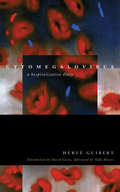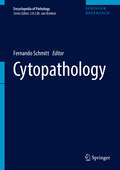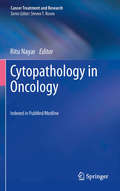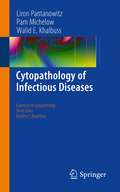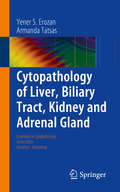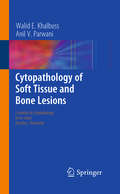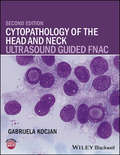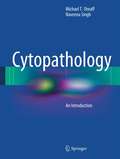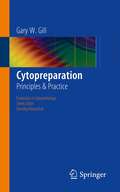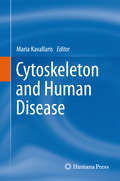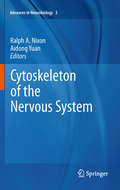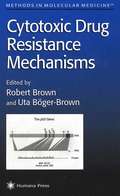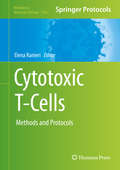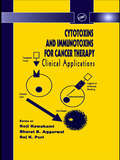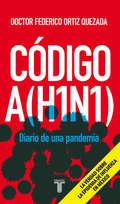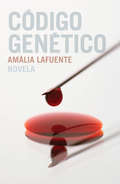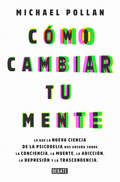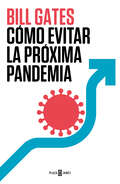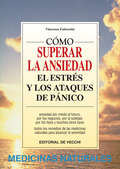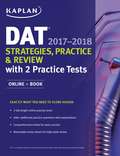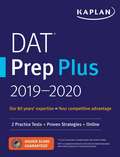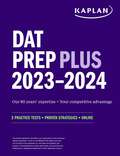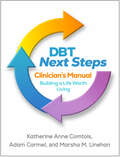- Table View
- List View
Cytomegalovirus: A Hospitalization Diary (Forms of Living)
by Hervé GuibertBy the time of his death, Herve Guibert had become a singular literary voice on the impact of AIDS in France. He was prolific. His oeuvre contained some twenty novels, including To the Friend Who Did Not Save My Life and The Compassion Protocol. He was thirty-six years old. In Cytomegalovirus, Guibert offers an autobiographical narrative of the everyday moments of his hospitalization because of complications of AIDS. Cytomegalovirus is spare, biting, and anguished. Guibert writes through the minutiae of living and of death—as a quality of invention, of melancholy, of small victories in the face of greater threats—at the moment when his sight (and life) is eclipsed.This new edition includes an Introduction and Afterword contextualizing Guibert’s work within the history of the AIDS pandemic, its relevance in the contemporary moment, and the importance of understanding the quotidian aspects of terminal illness.
Cytopathology (Encyclopedia of Pathology)
by Fernando SchmittThis book covers the complete field of the Cytopathology - from cytological findings of Acinic cell carcinoma Disease to Warthin tumor. The alphabetically arranged entries, each of which provides a detailed description of a specific pathological disease pattern, allow readers to quickly and easily find the information they need.
Cytopathology in Oncology (Cancer Treatment and Research #160)
by Ritu NayarIn recent decades, cytopathology has assumed an increasing role in the primary diagnosis of mass lesions owing to its ability to deliver rapid, non-invasive, and timely information. This book provides a comprehensive overview of the role of cytology at various body sites. The diagnostic details covered are abbreviated in comparison with those in pathology texts. Instead, a more clinical approach is taken, with the focus on the advantages and limitations of techniques and the key features of entities that are important to clinicians. Pathological-clinical correlation is highlighted throughout the book, ensuring that it will be highly relevant for clinicians. In particular, physicians who deal with oncology patients will find it to be a rich source of guidance on how to use and understand cytopathology in the diagnosis and exclusion of malignancy.
Cytopathology of Infectious Diseases (Essentials in Cytopathology #17)
by Walid E. Khalbuss Pantanowitz Liron Pam MichelowCytopathology of Infectious Diseases is the first book of its kind to focus entirely on the cytopathology of infectious diseases. It contains all of the pertinent information about the cytology of infectious diseases and microorganisms and will serve as an ideal handy reference. This unique volume covers the cytomorphology of various microorganisms and the host reactions they elicit, and also incorporates an update on advances in the field. Newly recognized infections such as the recent discovery of the Merkel Cell Polyomavirus (MCV) are included, as well as the utility of new immunostains (e.g. CM2B4 for MCV) and the role of molecular techniques that assist in the identification, classification and even quantification of microorganisms. Each chapter is succinctly written and concisely referenced with key published articles and resources. The volume includes practical pointers, useful diagnostic criteria, differential diagnoses and potential pitfalls. Many color images of high resolution that illustrate microorganisms (e.g. branching hyphae) and host reactions (e.g. viral cytopathic effect) are included throughout. Relevant tables with diagrams that provide quick reference guides are incorporated. Cytopathology of Infectious Diseases will serve as a valuable reference tool for cytopathologists, anatomical/clinical pathologists, cytotechnologists, pathology residents and cytopathology fellows.
Cytopathology of Liver, Biliary Tract, Kidney and Adrenal Gland (Essentials in Cytopathology #18)
by Yener S. Erozan Armanda TatsasThis volume fulfills the need for an easy-to-use and authoritative synopsis of intra-abdominal organ cytopathology. Part of the Essentials in Cytopathology book series, the book is heavily illustrated with a full color art program, while the text follows a user-friendly outline format. The book also fits into the lab coat pocket and is ideal for portability and quick reference. Written by authorities in the field, Cytopathology of the Liver, Biliary Tract, Kidney and Adrenal Glands is a concise and valuable resource to pathologists on the subject of intra-abdominal organ cytopathology.
Cytopathology of Soft Tissue and Bone Lesions (Essentials in Cytopathology #9)
by Anil V. Parwani Walid E. KhalbussSoft Tissue Cytopathology by Anil V. Parwani, MD, PhD and Walid E. Khalbuss, MD, PhD,will fulfill the need for an easy-to-use and authoritative synopsis of soft tissue cytopathology. This volume, part of the Essentials in Cytopathology book series, fits into the lab coat pocket and is ideal for portability and quick reference. Each volume in the series is heavily illustrated with a full color art program, while the text follows a user-friendly outline format. Anil V. Parwani, MD, PhD, is Associate Professor of Pathology at the University of Pittsburgh Medical Center - Shadyside Hospital, Pittsburgh, Pennsylvania. Walid E. Khalbuss, MD, PhD, is Associate Professor of Pathology at the University of Pittsburgh Medical Center - Shadyside Hospital, Pittsburgh, Pennsylvania.
Cytopathology of the Head and Neck: Ultrasound Guided FNAC
by Gabrijela KocjanWorking practices for Head and Neck (HN) diagnostic and clinical teams have changed dramatically over the past 15 years with highlighted importance on specialist Multidisciplinary Teams (MDT) including radiologists and cytopathologists. To achieve high levels of diagnostic accuracy in this modern working environment, special training and commitment to cytopathology are required in addition to histopathology. Cytopathology of the Head and Neck: Ultrasound guided FNAC supports the learning of new skills expected of practicing pathologists by providing a comprehensive approach to cytopathology, including performing FNAC and on site interpretation. New to this edition is coverage of ultrasound (US) guidance the use of which has emerged as an essential adjunct to either Fine Needle Aspiration Cytology (FNAC) or needle core biopsy, and is expected to increase. US combined with US guided FNAC is now recommended as the investigation method of first choice for HN lesions for evaluating regional metastases in HN patients, for both those with and those without palpable lumps. This second edition also includes: Companion website containing ultrasound case histories which detail imaging findings, list differential diagnosis and suggest further investigations compiled by Dr Simon Morley Expanded coverage of clinical images of head and neck masses Clear presentation of FNAC diagnostic features with images Clinical management algorithms Examples of diagnostic of pitfalls and complications in FNAC This timely book fills the training gap required for pathologists and offers a team approach to head and neck lesions, with valuable input from radiologists, ENT (ear, nose, and throat) surgeons, oncologists, and medico-legal experts. This new edition reflects the emergent multidisciplinary approach to head and neck practice.
Cytopathology: An Introduction
by Michael T. Sheaff Naveena SinghThis succinct book guides the trainee through the hurdles of fledgling cytology practice and can also be used throughout the career as an aide memoire by the more experienced. Whilst there are several well established and excellent textbooks on general cytology, these are by and large reference books rather than bench books that can lie beside each individual trainee's microscope and be resourced continually before and during each case. With numerous illustrations to enthuse the reader and make cytological practice a more enjoyable and educational experience, the book also highlights points of diagnostic difficulty, particularly with regard to the differentiation of neoplastic from non-neoplastic disease. This bench book will be an invaluable reference guide to histo- and cyto-pathology trainees as well as consultants who want a quick refresher/reference point.
Cytopreparation: Principles & Practice (Essentials in Cytopathology #12)
by Gary GillCytopreparation: Principles & Practice by Gary W. Gill fills a long-standing need for an easy-to-use and authoritative manual on the fundamentals of cytopreparation up-to-and- including microscopy, screening, and data analysis. The text describes in phenomenological terms the most common materials and methods of specimen collection through mounting for gyn, non-gyn, and FNA specimens, as well as the underlying mechanistic bases. The author provides his expertise and information that will empower and enable readers to review and improve their laboratories' cytopreparatory techniques as they apply to the vast majority of specimens. This unique volume provides facts that are not readily available anywhere. Cytopreparation: Principles & Practice is intended for everyone associated with, and involved in, making cytologic preparations that are useful for their intended purpose. It will serve as a valuable reference tool for educators in cytology and histology, cytotechnology and histotechnology students, cytotechnologists, cytopreparatory technicians, cytopathologists, anatomical/clinical pathologists, pathology residents and cytopathology fellows.
Cytoskeleton and Human Disease
by Maria KavallarisThe cytoskeleton is comprised of a variety of specialized proteins, and is a dynamic structure that is involved in the majority of key cellular events. There is increasing interest in the role of the cytoskeleton in human disease. This volume brings together human disease states where cytoskeletal disruptions are driving disease. Our emerging understanding of the molecular and cellular events that drive cytoskeletal mediated diseases including cancer, heart disease, myopathies and skin disorders, are also helping shape targeted therapeutic approaches to treating these diseases.
Cytoskeleton of the Nervous System (Advances in Neurobiology #3)
by Ralph A. Nixon Aidong YuanThis monograph begins with a general description of the cytoskeleton in axonal development and pathology and then moves to more detailed descriptions of particular components, including microtubules and associated proteins, neurofilaments and interacting proteins, actin and its binding proteins, and glial fibrillary acidic protein. The later chapters focus on the functional significance of the neuronal cytoskeleton in axonal transport and its regulation in health and disease states. The Cytoskeleton of the Nervous System will encourage further development of unifying principles and stimulate new conceptual and technical approaches toward a better understanding of cytoskeleton functions in health and disease.
Cytotoxic Drug Resistance Mechanisms (Methods in Molecular Medicine #28)
by Robert Brown Uta Böger-BrownLeading clinical and laboratory scientists describe cutting-edge methods for examining the mechanisms of cellular resistance to anticancer cytotoxics in human tumors. The protocols contain detailed instructions and extensive troubleshooting tips that allow researchers effectively to study a wide variety of drug resistance mechanisms, including aspects of drug-induced cell death, drug uptake/efflux, drug metabolism, and DNA repair. Each method is designed to help identify the correlation between molecular and biochemical data and the clinical responses of the patient. Cytotoxic Drug Resistance Mechanisms illuminates all the clinically relevant mechanisms used as markers of the biological response to anticancer biotherapeutics today.
Cytotoxic T-Cells: Methods and Protocols (Methods in Molecular Biology #1186)
by Elena RanieriIn Cytotoxic T-Cells: Methods and Protocols, leading experts in the field provide a collection of state-of-the art methods and protocols encompassing a wide array of systems biology approaches for Cytotoxic T-Cell research. Dived into three main sections, the first part of the volume analyzes the isolation of T Cells along with their expansion and characterization according to different methods. The second part describes required techniques for intracellular signaling, monitoring of antigen T cell specific responses, CTL exosomes, and microscopy and in vivo imaging applied to CTL studies. The final section focuses on specialist applications of molecular methods into the study of CTL, including next generation sequencing of the Jack/stat pathway and CTL involvement in bone remodeling and transplantation. Written in the highly successful Methods in Molecular Biology series format, chapters include introductions to their respective topics, lists of the necessary materials and reagents, step-by-step, readily reproducible laboratory protocols, and key tips on troubleshooting and avoiding known pitfalls. Authoritative and practical, Cytotoxic T-Cells: Methods and Protocols seeks to aid scientists in the further study into concepts of laboratory methods using systems biology.
Cytotoxic T-Cells: Methods and Protocols (Methods in Molecular Biology #2325)
by Elena Ranieri Margherita GiganteThis new edition explores lab protocols describing new techniques to study cytotoxic T-cells (CTLs), as well as chapters of a more general discursive nature, all with an emphasis on the use of systems biology in immunology. Beginning with phenotypical characterization of CTL populations, the volume continues with in vitro and in vivo cytotoxicity assays, methods to detect senescent T cells, in vivo and in vitro models to understand immune and bone cells cross-talk, microscopy and in vivo imaging, as well as “Omics” approaches and molecular methods, concluding with chapters on CTL involvement in transplantation and link microbiota-immunity. Written for the highly successful Methods in Molecular Biology series, chapters feature the kind of detail and key implementation advice for best results in the lab. Authoritative and up-to-date, Cytotoxic T-Cells: Methods and Protocols, Second Edition serves as an ideal guide for researchers working with these vital cells.
Cytotoxins and Immunotoxins for Cancer Therapy: Clinical Applications (Pharmaceutical Science Ser.)
by Bharat B. Aggarwal Koji Kawakami Raj K. PuriRecent advances in cytotoxins and immunotoxins are accelerating our understanding of cancer and leading to more effective therapeutic treatments. Although a large number of articles have been published on these cytotoxins and immunotoxins, this important information has yet to be compiled into one comprehensive resource.For the first time,
Cáncer de mama: No le des la espalda
by Juan Carlos Acevedo Gonzalo Rojas - MayEs un libro testimonial y educativo que recoge la experiencia de décadas dedicadas a la educación, prevención y tratamiento de uno de los cánceres de mayor frecuencia en el mundo de hoy. El Centro Integral de la Mama de Clínica Las Condes fue fundado en 1995, está constituido por profesionales altamente calificados, dedicados en forma exclusiva a la prevención, educación, diagnóstico precoz y tratamiento de las enfermedades de la glándula mamaria, especialmente del cáncer de mama. Este cáncer es la primera causa de muerte en la mujer a nivel mundial, se estima que en Chile, una de cada catorce mujeres lo desarrollará a lo largo de su vida. Cuanto más precoz es el diagnóstico, mayor es la posibilidad de cura y sobrevida. En este sentido la educación es clave, el autocuidado de toda mujer comienza con una información adecuada, autoexámenes periódicos y controles médicos anuales. Este libro es una invitación a ello. El cáncer de mama se suele tratar solo desde el punto de vista médico, sin embargo, para los profesionales del Centro Integral de la Mama de Clínica Las Condes, hay otra forma de hacerlo. No es casualidad el uso de la palabra "integral", esta idea apunta a un tratamiento multidisciplinario, altamente complejo y personalizado, ya que para este equipo de profesionales cada paciente tiene un nombre, una historia personal y una familia que la hacen única. No le des la espalda no es un libro de medicina, es un libro testimonial y educativo que recoge la experiencia de décadas dedicadas a la educación, prevención y tratamiento de uno de los cánceres de mayor frecuencia en el mundo de hoy.
Código A(H1N1)
by Federico Ortiz QuezadaLa verdad sobre la pandemia de influenza en México El Dr. Ortiz Quezada responde a las interrogantes que la epidemia A(H1N1) despertó en la sociedad mexicana y el mundo: ¿Se originó en México? ¿Han mutado los virus? ¿Cómo se han desarrollado las vacunas? ¿Cuáles son los grupos de alto riesgo? ¿Qué tan peligrosas son las complicaciones? ¿Existe un tratamiento eficaz? ¿Es la amenaza del futuro?
Código genético
by Amàlia LafuenteMarina Fontcuberta, becaria posdoctoral, es la encargada de una línea de investigación sobre un fármaco contra el Alzheimer. Cuando llega un nuevo director al Instituto de Neurociencias, avalado por una carrera brillante en Estados Unidos, él apoya su trabajo con gran interés. Sin embargo, Marina descubrirá que las atenciones que le presta sobrepasan el terreno profesional y se verá obligada a tomar una decisión que podría poner toda su carrera en peligro.Amàlia Lafuente retrata con habilidad el mundo de la investigación científica: la rivalidad entre los becarios, el abuso de poder de los triunfadores, la competitividad, los juegos de seducción entre colegas de profesión...Con todos los ingredientes del mejor thriller, Código genético atrapa al lector con un tema de actualidad y unos personajes de carne y hueso.
Cómo cambiar tu mente: Lo que la nueva ciencia de la psicodelia nos enseña sobre la conciencia, la muerte, la adicción, la depresión y la transcendencia
by Michael PollanUna brillante y valiente investigación de Michael Pollan, autor de cinco best sellers de The New York Times, sobre la revolución médica y científica en torno a las drogas psicodélicas, y la fascinante historia de sus propias experiencias psicodélicas que le cambiaron la vida. Cuando Michael Pollan se propuso investigar por qué el LSD y la psilocibina (el ingrediente activo de las setas mágicas) brindaban un enorme alivio a las personas que padecían condiciones difíciles de tratar como el TEPT (trastorno por estrés postraumático), la depresión o la adicción, no tenía la intención de escribir lo que es indudablemente su libro más personal. Pero al descubrir cómo estas notables sustancias estaban mejorando la vida no solo de los pacientes con problemas de salud mental sino también de las personas que simplemente se enfrentaban a los altibajos de la vida cotidiana, decidió explorar los límites de la mente en primera y tercera persona. Así comenzó una singular aventura entorno a la experiencia de la conciencia alterada, así como una profunda inmersión en el estudio de la neurociencia más pionera y la toma de contacto con una prodigiosa comunidad subterránea de expertos psicodélicos. En esta ejemplar investigación periodística, Pollan revisa archivos históricos y documentos científicos para separar la verdad sobre estas misteriosas drogas de los mitos, la propaganda y el pánico moral que se ha ido acumulando desde los años sesenta, cuando un puñado de personajes rebeldes catalizaron una poderosa reacción contra lo que entonces era un prometedor campo de investigación. Sugerente, polémico y deslumbrante este libro es el resultado de un viaje a una nueva, emocionante e inesperada frontera de la percepción, de nuestra comprensión de la mente, del yo y de nuestro lugar en el mundo.
Cómo evitar la próxima pandemia
by Bill GatesLa pandemia de la COVID-19 aún no ha terminado, pero mientras los gobiernos del mundo entero tratan de dejarla atrás, ya se plantean qué pasará a continuación. ¿Cómo podemos evitar que una próxima pandemia les arrebate la vida a millones de personas y hunda la economía global? ¿Podemos siquiera albergar la esperanza de alcanzar esta meta? Bill Gates cree que la respuesta es sí, y en este libro explica de un modo claro y convincente qué deberíamos haber aprendido de la COVID-19 y qué podemos hacer cada uno de nosotros para evitar un desastre parecido. Basándose en los conocimientos de los principales expertos mundiales y en su propia experiencia combatiendo enfermedades mortales a través de la Fundación Gates, logra, en primer lugar, ayudarnos a entender, desde un punto de vista científico, cómo funcionan las enfermedades infecciosas. Después, nos enseña que, si las naciones del mundo aúnan esfuerzos y al mismo tiempo trabajan codo con codo con el sector privado, no solo podrán prevenir otra catástrofe como la de la COVID, sino también eliminar todas las afecciones respiratorias, incluso la gripe. Este es un llamamiento intenso, exhaustivo y de suma importancia realizado por uno de nuestros más grandes y más eficaces pensadores y activistas. «En este libro, conciso a la par que coherente, Gates reflexiona sobre la COVID-19, considera futuras pandemias y propone recomendaciones sensatas para su prevención. Apasionado por el tema pero sin sentar cátedra, Gates hace un llamamiento razonado y consistente al mundo para que se una a fin de evitar próximas pandemias».Booklist «Gates aporta un análisis exhaustivo sobre cómo lo aprendido de la COVID-19 puede ayudar a desarrollar políticas globales de salud pública. Con una prosa accesible, detalla los pasos necesarios para evitar pandemias futuras, destacando la creación de un equipo internacional dedicado a ello».Publishers Weekly
Cómo vencer la ansiedad, el estrés y los ataques de pánico
by Vincenzo Fabrocini* La ansiedad perturba el ánimo y lo llena de temor, preocupación, incertidumbre, recelo, aprensión y espera. Sus causas son muy diversas conscientes o inconscientes * En este libro se proponen muchas terapias, que se pueden alternar, de forma que los distintos efectos se unan para un mismo fin * Para superar la ansiedad es necesario recorrer varios caminos: aquí encontrará una treintena de métodos biológicos que afectan al pensamiento (técnicas biomédicas) y a la acción (técnicas biofísicas). Sígalas cada día durante por lo menos dos semanas * No tenga miedo: si se ciñe a las indicaciones que se dan, ninguna de las terapias entraña riesgos para su salud. De todos modos, si prefiere someterse a ellas con más seguridad, puede solicitar el consejo de un especialista * Después de dos semanas, si no se siente mejor, rehaga el plan terapéutico. No olvide que probar una y otra vez era el lema de Galileo Galilei, padre de la investigación científica moderna Vincenzo Fabrocini, cirujano, publicista y licenciado en filosofía y letras, se dedica a la divulgación y difusión de terapias complementarias de la medicina oficial. Es presidente del comité de bioética La Torre de Turín. Ejerce de consultor medicolegal y realiza diagnósticos terapéuticos
DAT 2017-2018 Strategies, Practice & Review with 2 Practice Tests: Online + Book
by KaplanWith Kaplan's DAT 2017-2018 Strategies, Practice & Review, you will gain an advantage by earning a higher Dental Admissions Test score - guaranteed or your money back. This book has all of the content and strategies you need to get the DAT results you want, including: * 2 full-length, online practice tests * 600+ practice questions * A guide to the current DAT Blueprint so you know exactly what to expect on Test Day * Kaplan's proven strategies for Test Day success * Comprehensive review of all of the content covered on the DAT: Biology, General Chemistry, Organic Chemistry, Perceptual Ability, Reading Comprehension, and Quantitative Reasoning * 12-page, tear-out, full-color study sheets for quick review on the go * Practice questions for every subject with answers and explanations Kaplan also offers a wide variety of additional DAT preparation options including online programs, books and software, classroom courses, and one-on-one tutoring. For more information about live events, courses, and other materials, visit KaplanDAT.com.
DAT Prep Plus 2019-2020: 2 Practice Tests + Proven Strategies + Online (Kaplan Test Prep)
by Kaplan Test PrepKaplan's DAT Prep Plus 2019-2020 provides the test-taking strategies, realistic practice, and expert guidance you need to score higher on the Dental Admissions Test. Our comprehensive updated subject review reflects recent changes to the blueprint of the exam, question types, and test interface. You'll get two full-length practice DATs and expert tips to help you face Test Day with confidence.The Best ReviewTwo updated full-length, online practice exams for test-like practiceStudy planning guidanceMore than 600 practice questions for every subject, with detailed answers and explanationsFull-color study sheets for high-yield reviewA guide to the current DAT Blueprint so you know exactly what to expect on Test DayComprehensive review of all of the content covered on the DATExpert GuidanceOur books and practice questions are written by veteran teachers who know students—every explanation is written to help you learnKaplan's experts ensure our practice questions and study materials are true to the testWe invented test prep—Kaplan (www.kaptest.com) has been helping students for 80 years, and our proven strategies have helped legions of students achieve their dreamsThe previous edition of this book was titled DAT 2017-2018 Strategies, Practice & Review.
DAT Prep Plus 2023-2024: 2 Practice Tests + Proven Strategies + Online (Kaplan Test Prep)
by Kaplan Test PrepKaplan's DAT Prep Plus 2023–2024 provides the test-taking strategies, realistic practice, and expert guidance you need to score higher on the Dental Admissions Test. Our comprehensive subject review reflects recent changes to the blueprint of the exam, question types, and test interface. You'll get two full-length practice DATs and expert tips to help you face Test Day with confidence.We're so confident that DAT Prep Plus offers all the knowledge you need to excel at the DAT that we guarantee it: after studying with our online resources and book, you'll score higher on the DAT—or you'll get your money back.The Best ReviewTwo updated full-length, online practice exams for test-like practiceStudy-planning guidanceMore than 600 practice questions for every subject, with detailed answers and explanations12-page full-color study sheets for high-yield review on the goA guide to the current DAT Blueprint so you know exactly what to expect on Test DayComprehensive review of all of the content covered on the DATExpert GuidanceOur books and practice questions are written by veteran teachers who know students—every explanation is written to help you learn.Kaplan's experts ensure our practice questions and study materials are true to the test.We invented test prep—Kaplan (www.kaptest.com) has been helping students for 80 years, and our proven strategies have helped legions of students achieve their dreams
DBT Next Steps Clinician's Manual: Building a Life Worth Living
by Marsha M. Linehan Katherine Anne Comtois Adam CarmelDeveloped over 25 years by preeminent experts, DBT Next Steps is a groundbreaking expansion of standard Dialectical Behavior Therapy (DBT) for clients who have moved beyond crisis behaviors--yet haven't achieved their goals in such areas as employment, school, and relationships. Combining skills training with exposure, contingency management, cognitive modification, and didactic strategies, DBT Next Steps fills a gap by systematically targeting quality-of-life-interfering behavior. In a convenient large-size format, this authoritative clinician's manual provides detailed lesson plans for six brand-new DBT skills modules: Perfectionism versus Reinforcement, Establishing and Re-Evaluating Relationships, Time Management, Managing Emotions Effectively, Succeeding after DBT, and Applications of Mindfulness. It shows how Next Steps can be incorporated into an existing DBT program or used as a follow-up treatment. Reproducible skills training handouts and assignments are provided in the related client resource, available separately: DBT Next Steps Skills Handouts.
